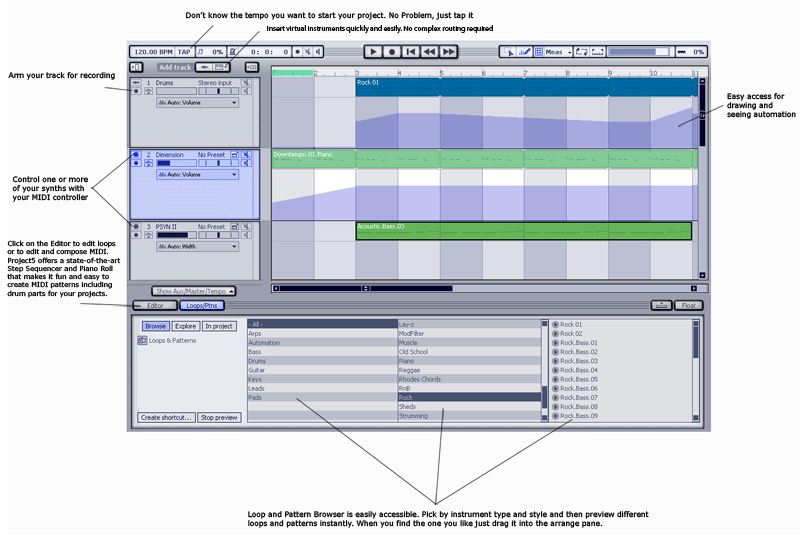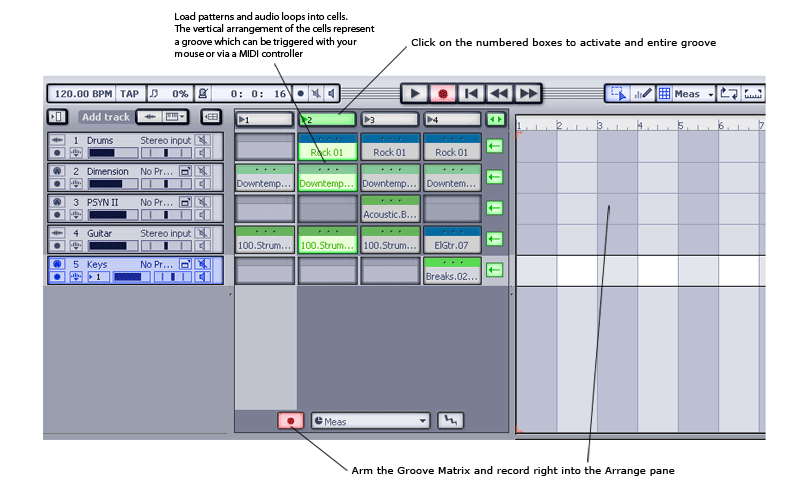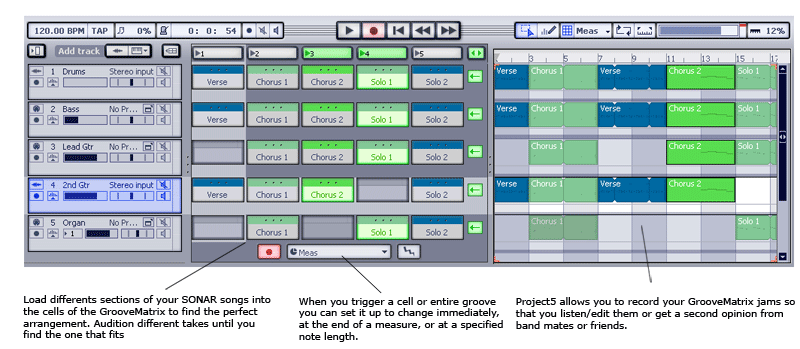The Benefits of Using SONAR and Project5
Last updated on 3/29/2016Project5 and SONAR make a great team for music creation, complimenting each other on many levels. You might ask “why do I need Project5 if I already have SONAR?” That’s an excellent question and no one is going deny that SONAR 5 is a complete digital audio workstation. What Project5 adds is a new and different way of creating music. It’s similar to the guitar player who takes up piano in order to expand his or her songwriting ability. While the guitar may be their instrument of choice, often times working with another instrument that is laid out in a different way can spark a new way of looking at music. Below are just a few of the ways Project5 can expand and enrich your musical creativity.
Turning those musical ideas into realities
Often times, you will get an initial idea in your head for a song. Maybe it’s a hook, bass line, or just simply a drum beat. Project5 makes for an ideal environment to start laying out a song, because it provides powerful pattern-based composition tools. And because Project5 is designed so that all the tools you need are right at your fingertips, you can easily grab loops, patch a virtual instrument, or record an acoustic instrument.
In Project5, adding a virtual instrument is just one click away, but getting started with an idea in Project5 is made even faster with Device Chains. With a single click, you can patch all of the elements of a sound, with the settings pre-selected for your Instrument, MIDI effects, arpeggiator, audio effects, and mix settings. This saves you the time of loading and finding settings for each individual element in your sound, and lets you start making music faster. Project5 includes over a thousand Device Chains for you to get started, and you can make your own for your own custom sounds, allowing you to recall elaborate combinations in an instant.
Previewing and dragging an audio loop or MIDI pattern for an instrument is a mouse click and drag away; arming a track to record any acoustic instrument is one click away—and everything is in front of you in one integrated, pattern-based view. SONAR users will also enjoy the Piano Roll/Step Sequencer view which makes it even easier to compose MIDI patterns or create drum parts with lifelike embellishments like flams.
Once you have an idea in Project5 you can then bring it into SONAR via ReWire to take advantage of its more advanced audio recording, editing, and mixing capabilities, or export the parts you would like to keep as .wav or .ptn (Project5 pattern) files and import them into SONAR.

Find new inspirations
As we mentioned earlier, working in Project5 can stimulate your creativity in a different way than SONAR. Project5 includes 4 versatile instruments and 10 studio-quality effects that are not included in SONAR 5, including the critically-acclaimed Dimension synth and Alias Factor bit decimator/low pass filter. Using these virtual instruments and effects inside Project5 will certainly get the creative juices flowing, however Project5 also includes many other features that allow you to think outside of the box. For example, each track has a built-in arpeggiator which allows you to turn even the simplest of patterns into exciting new sound textures. You can even use MIDI patterns created in SONAR, and run them through the Project5 arpeggiator to breathe new life into them. The Arpeggiator is also a perfect tool for adding variety to a chord progression that repeats a number of times in a song, or for creating new complimentary parts using other instrument sounds that follow your chord progression.

Live performance
One of the cool new features in Project5 is the GrooveMatrix. With GrooveMatrix, you can trigger patterns and audio loops in real-time. While SONAR has capabilities for live performance, Project5’s GrooveMatrix was designed to be taken on the road.
Today you see many bands using computers to play certain parts of their songs in lieu of an actual musician. Sometimes it’s hard to afford a tabla player and a cellist to sit in on your gigs for that one song that requires those parts. Or maybe you created a dense layered section for a part of a song and your keyboard player only has two arms and ten fingers…you get the point. You can use the GrooveMatrix to reinforce your live sound by triggering audio loops, synth patterns, or samples, and it’s easy to take parts of your SONAR project and load them into the cells of GrooveMatrix for live playback.
You can trigger these cells with a mouse or via MIDI remote control. You can even make the patterns or loops “one-shots”, and specify whether they play immediately, at the end of a measure, or at the end of a specified note length when triggered. If you are strictly looking to perform live music using a computer, you will find the GrooveMatrix extremely intuitive and easy-to-use. Just load your patterns or audio loops into cells in a vertical arrangement to form grooves. Once you have created grooves, you can trigger them using your mouse or a MIDI controller for real-time performance. Another great feature is the ability to trigger only certain cells within a groove or certain cells from different grooves that will playback at the same time. This kind of detailed control of the GrooveMatrix can create some interesting sounds that can often lead to the creation of new songs. You can always record any GrooveMatrix session into your Arrange pane for further editing and manipulation or just to listen and reflect on your spontaneous jam.
Project5 is also great for live use as a synth host. You can setup Project5 for use with multiple controllers, layered sounds, or even keyboard splits without any hassles or complex programming.

Jamming on arrangements
As we mentioned before, GrooveMatrix offers SONAR users a new way of creating spontaneous jams. In addition, GrooveMatrix can be used to work out and test new arrangements. For example, let’s say you are working on a song that has a verse, chorus, and solo. You might be unsure if your chorus works with the verse, of if the chorus leads well into the solo. You might even have alternate takes of the chorus and solo that you feel might work better within the arrangement. In SONAR, you would have to mute/unmute these different takes and play them back while looping your project. Instead of using SONAR, you can create loops of your verse, chorus, and solo and load them into the GrooveMatrix as grooves and play them back real-time. You can trigger any part of your song with your mouse or a MIDI controller to get a real-time feeling for the song, while never stopping playback or having to mute any section. For example you can trigger the verse and let it play, then trigger the first chorus take to hear how it sounds. Trigger the verse again and then play the second chorus take and compare the sound. Go from the chorus into the solo take or compare it to another solo take. Maybe the solo part was built on the melody of your rhythm guitar part and you want to preview the solo groove while adding just the rhythm guitar part from the chorus. What’s more, it’s easy to create variations of a verse or chorus by duplicating a groove and adding or removing a pattern within. If you need a second opinion, you can record the arrangement jams and play them back at a later time to band mates or friends. The possibilities are endless and the results can make you realize your song faster than ever imagined.

As you can see, Project5 can give SONAR users the edge they need to take their music to the next level. Project5 compliments SONAR in so many ways, but more importantly it offers SONAR users a new way of creating music and finding inspiration. SONAR users will see many benefits using SONAR/Project5 combination, whether it’s via ReWire or just working between the two applications.